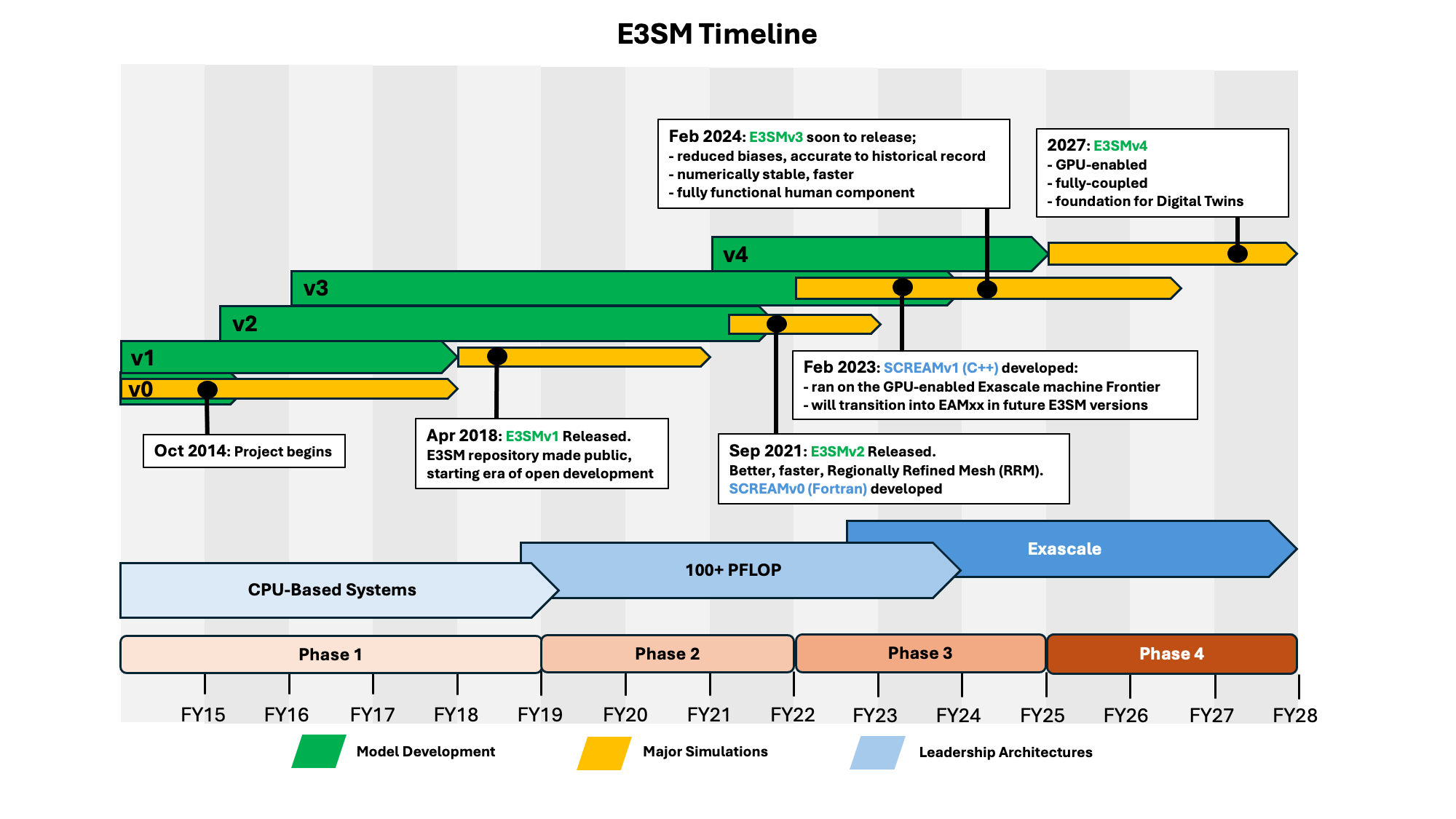E3SM – A Decade of Progress: A Timeline
 The Energy Exascale Earth System Model (E3SM) project began with a 10-year vision in mind: modeling the climate on exascale machines. That bold decadal vision was achieved in 2023 and was recognized with the Gordon Bell Prize in Climate Modeling. Let’s look back at the decade of progress and end with a look ahead to the beginnings of a new decadal vision as E3SM enters its second decade.
The Energy Exascale Earth System Model (E3SM) project began with a 10-year vision in mind: modeling the climate on exascale machines. That bold decadal vision was achieved in 2023 and was recognized with the Gordon Bell Prize in Climate Modeling. Let’s look back at the decade of progress and end with a look ahead to the beginnings of a new decadal vision as E3SM enters its second decade.
The project officially began in October 2014, starting the first multi-year funding period, known as Phase 1. At that time the project was called the Accelerated Climate Modeling for Energy (ACME) and began with a fork from the CESM model identified as ACME version 0 (ACMEv0).
April 2018 saw the change of the project’s name to Energy Exascale Earth System Model (E3SM) and the release of E3SM version 1 (v1). v1 sought to answer specific scientific questions in three areas:
- Water Cycle: How will more realistic portrayals of features important to the water cycle (clouds, aerosols, snowpack, river routing, land use) affect simulations of river flow and associated freshwater supplies at the watershed scale?
- Biogeochemistry: What are the effects of nitrogen and phosphorous on climate-biogeochemistry interactions, and how sensitive are these interactions to model structural uncertainty?
- Cryosphere: What are the impacts of ocean-ice shelf interactions on melting of the Antarctic Ice Sheet, the global climate, and sea level rise?
Concurrent with v1’s release, E3SM’s GitHub repository was made public, starting the era of open development.
Phase 2 began in 2018 and in September 2021, E3SMv2 was released as a better, faster version. The regionally refined model (RRM) was now included as well in all its components! v2 sought to answer updated science questions:
- Water Cycle: What are the relative impacts of global forcing versus regional effects of human activities on flood and drought in North America?
- Biogeochemistry: What are the implications of different energy futures for the biogeochemical cycle through changes in land use land cover, water availability, and extreme events?
- Cryosphere: How will the atmosphere, ocean and sea-ice systems mediate sources of sea-level rise from the Antarctic ice sheet over the next 30 years?
Meanwhile, the future Gordon Bell prize-winning team started developing a FORTRAN prototype of the Simple Cloud Resolving E3SM Atmosphere model (SCREAMv0).
E3SM entered Phase 3 in 2023 and soon thereafter completed SCREAMv1, a “clean sheet” new model written in C++/Kokkos to run on GPU-enabled machines. SCREAMv1, ran on the GPU-enabled exascale machine Frontier, breaking the 1 SYPD (Simulated Year Per Day) barrier and ultimately earning the team the Gordon Bell Prize in Climate Modeling and realizing the decadal vision from E3SM’s founding. SCREAMv1 is the foundation for all future versions of EAM (named EAMxx for C++ versions) starting with EAMv4.
E3SM v3 will soon be released. E3SMv3 has reduced biases allowing for a more accurate reproduction of the historical record – a major advancement from E3SMv1 and v2. It is also numerically stable and faster. Building on E3SMv3, a new capability of coupling E3SM with the Global Change Analysis Model (GCAM) to represent human-Earth system feedback will be added in E3SMv3.x. v3 seeks to answer further updated science questions:
- Water Cycle Changes and Impacts: What are the relative contributions of model parametric uncertainty and internal variability to uncertainty in projecting future changes in water availability and water security, including the impacts of extreme events?
- Human-Earth System Feedbacks : What are the impacts of different US decarbonization scenarios on US regional climate and evolution of the human–Earth systems?
- Polar Processes, Sea-Level Rise, and Coastal Impacts : What polar processes and their model representations contribute to key uncertainties in projecting regional sea level rise?
So, what’s next for E3SM?
The project team has begun the development of a new decadal vision. A review of the project will commence in the fall of 2025 before proceeding with Phase 4 of the project which is expected to begin in 2026. The project is targeting 2027 for a release of E3SMv4, which is envisioned to be a fully coupled, GPU-enabled E3SM (written in C++ for most components) as a foundation for a Digital Twin of the Earth System globally and regionally.
On the verge of delivering an Exascale modeling system, the achievements and progress during the 1st decade set a high bar for what the project could achieve into the future. In the process of developing its new decadal strategic plan, the team’s vision at the high level includes efforts to:
- Explore ever-more disruptive approaches beyond exascale such as edge computing, machine learning (ML), and next-generation artificial intelligence (AI) to accelerate the fusion of observations and measurements with computing;
- Continuously integrate advanced technologies and Earth system science to deliver capabilities for multi-resolution modeling of the coupled human–Earth system;
- Enable E3SMv4 to be at the center of a connected scientific DOE ecosystem for understanding and modeling the Earth system, and will be the foundation for digital twins of the earth system and its components;
- Lead in actionable projections of human–Earth system evolution across a broad range of temporal and spatial scales to support multisectoral decision making and DOE’s energy mission.
The new decadal strategic plan will serve as a road map for the remaining of the Phase 3, Phase 4, and Phase 5 into 2033, and guide the development and delivery of E3SMv5 and E3SMv6. The team is poised to tackle future grand challenges and is excited by what the next decade will bring, the new scientific discoveries and innovations that E3SM could enable for DOE’s energy science mission.
Reference to Overview Articles
- E3SMv1 Overview Paper on Coupled Model (Standard or Low Resolution, LR)
- E3SMv1 High-Res Overview Paper on Coupled Model
- E3SMv1.1 BGC Overview Paper
- Overview Paper on Cryosphere Configuration
- Overview Paper for the Doubly-Periodic SCREAM Configuration (DP-SCREAM)
- E3SMv2 Overview Paper (LR)
- E3SMv2.0 North American Regionally Refined Model (NARRM) Overview Paper
E3SM Data
This article is a part of the E3SM “Floating Points” Newsletter, to read the full Newsletter check:



